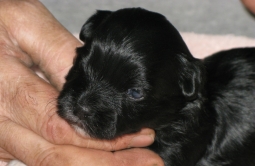
POINTS OF CONFUSION - Charcoal vs. Silver
The difference here is very subtle and it is one that cannot truly be seen or determined with complete accuracy. Ultimately, it remains a best-guess answer. The addition of the silvering gene changes the colour of a black dog and causes it causes it to progressively lighten. One copy of the gene changes the colour somewhat while two copies of the gene does it to a greater extent. You can find more information and more photos on the definitions pages and in the colour galleries.
Charcoal Silver


Charcoal vs. Silver
Charcoal and Silver are just names to differentiate between two extremes of the same thing (effect of the silvering gene). Charcoal is the name sometimes given to the darkest silver shades while silver is used for the lighter and medium shades. That is not absolute as there is a broad range common colour in the middle, where the lightest of the dark shades and darkest of the light shades overlap. Birth colour, eye colour and pigment colour are also of no help in trying to determine whether the dog carries one or two copies of the silvering gene. All are born black. All have the same black pigment colour. So how can you tell?
Black? Charcoal? Silver?

As a puppy
A black Havanese is born black. If he carries the silvering gene, his coat colour will progressively change as he matures, but at birth, he cannot be distinguished from a black puppy. The colour change is where the real clues lie. A Havanese that carries two copies of the silvering gene will generally start turning at a younger age and will lighten further. A Havanese that carries only one copy of the gene will start the change later in life and will not lighten as much. While final colour may give some indication, it is the progression and timing of the colour change that provides the answers.
Silver
Early start - Rapid transition - significant change
The puppy with two copies of the silvering gene starts to silver very quickly. By 4 to 6 weeks of age, silvering is evident. The change generally starts on the face and muzzle as well as the paws. The change is rapid. Within a few months the puppy is very noticeably silver. The colour may soften more as the dog matures but the colour change is generally complete by about 12 months of age. Interestingly, the colour may lighten and deepen slightly in phases throughout the dog's life.
Charcoal/dark silver
Late start - slow transition - subtle change
The puppy with only one copy of the silvering gene does not start to change until he is older, usually as an adolescent or young adult. The change may begin as early as 5-6 months of age or as late as 12-15 months of age. The silvering does not happen in the same way as above. In this case, the silvering starts with a subtle shift to a dull reddish black and often progresses through a grey/brown phase before developing the characteristic dark grey colour. The colour change is slow and may progress over 2 to 3 years before it is complete.
NEXT ... Havana brown vs. chocolate

